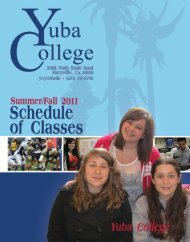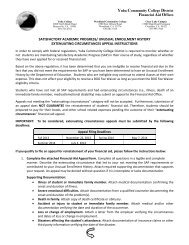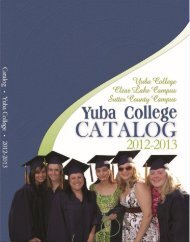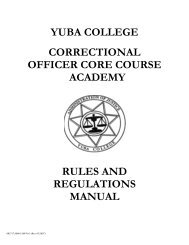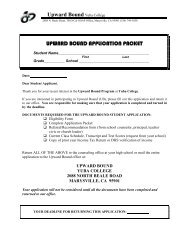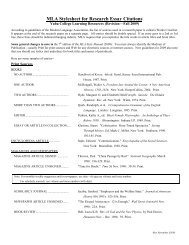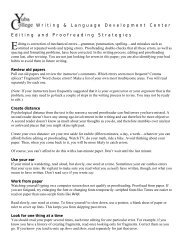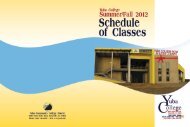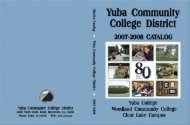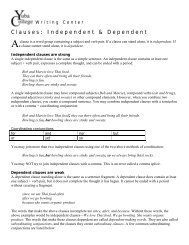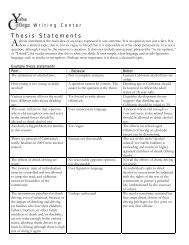yuba college basic police academy rules and regulations manual
yuba college basic police academy rules and regulations manual
yuba college basic police academy rules and regulations manual
You also want an ePaper? Increase the reach of your titles
YUMPU automatically turns print PDFs into web optimized ePapers that Google loves.
YUBA COLLEGEInter-Department CorrespondenceDate: ____________________TO:BASIC ACADEMY FACILITATORFROM:_____________________________________SUBJECT:RECEIPT OF RULE AND REGULATIONS, BASIC ACADEMYI hereby acknowledge receiving a copy of the “Basic Academy Rules <strong>and</strong> Regulations.”I underst<strong>and</strong> that as of the date listed above, if I fail to comply with the policies <strong>and</strong>procedures in the “Basic Academy Rules <strong>and</strong> Regulations”, I may receive disciplinaryaction up to <strong>and</strong> including dismissal from the Academy._________________________________________Student Signature_____________________________Date005717.00001/56470v1-(Rev 12/2008)
ACADEMY RULES AND REGULATIONSTABLE OF CONTENTSClass OfficersPlatoon Leader…………………………………………………………………… 31Platoon Sergeant………………………………………………………………… 31Squad Leader……………………………………………………………………. 33Assistant Squad Leader………………………………………………………… 33Color Guard………………………………………………………………………. 34Guidon Bearer………………………………………………………………… 34Attendance & GradingAttendance Requirements……………………………………………………… 35Critical Subjects…………………………………………………………………. 35Special Career Classes…………………………………………………..…….. 38Grading…………………………………………………………………………… 38Pregnancy………………………………………………………………………... 43Academy Difficulties…………………………………………………………….. 43FirearmsPossession for Training ………………………………………………………… 45Illness & InjuryReporting Procedure……………………………………………………………. 46Modifications to Physical Training……………………………………………… 47MiscellaneousCommunication & Memor<strong>and</strong>ums……………………………………………... 48Leaving Early…………………………………………………………………….. 48Message Board………………………………………………………………….. 48Telephones, Pagers, Cell Phones…………………………………………….. 49Transportation…………………………………………………………………… 49Military Obligations……………………………………………………………… 50Subpoenas………………………………………………………………………. 50Graduation………………………………………………………………………. 50005717.00001/56470v1-(Rev 12/2008)
YUBA COLLEGEPUBLIC SAFETY CENTERBASIC ACADEMYSTUDENT POLICIES AND PROCEDURES MANUALMISSION STATEMENTThe Yuba College Basic Police Academy is dedicated to the education <strong>and</strong> professionalachievement of students planning to enter careers in law enforcement. The Academy iscommitted to the philosophy of proactive, problem solving collaborative strategies between lawenforcement personnel <strong>and</strong> private citizens as the most effective way to safeguard lives,neighborhoods, <strong>and</strong> cities.The administration, faculty, <strong>and</strong> staff affirm their attention to affect student success inCommunity Oriented Policing through emphasis of: critical thinking, ethical action solving,professional values, individual responsibilities, interpersonal communication, appreciation ofcontributions of other cultures, <strong>and</strong> cooperative civic responsibility.The College is committed to ensuring that these men <strong>and</strong> women are thoroughly prepared toprovide positive partnerships for the improvement of public safety <strong>and</strong> an enhanced quality oflife for the diverse communities they intend to serve.OBJECTIVESThe resources devoted to this <strong>academy</strong> are for the purpose of providing students with the highestquality instruction. The course content <strong>and</strong> required instructional hours are in accordance withthe st<strong>and</strong>ards <strong>and</strong> m<strong>and</strong>ates set forth by the California Commission on Peace Officer St<strong>and</strong>ards<strong>and</strong> Training (P.O.S.T.) guidelines <strong>and</strong> directions from the Advisory Committee.The successful students who complete this Academy can be assured that they have received thebest available training. This preparation will enable them to perform the required functions oftheir new profession.To receive <strong>college</strong> credit for the Academy, students must successfully complete all Academyrequirements. If a student fails to complete any <strong>academy</strong> requirement that results in noncertification,that student will receive an “incomplete” for the AJ-58R Academy Course.However, the student will have to take the entire course, within a year or an “F” grade will berecorded on the student’s permanent <strong>college</strong> transcript.ACADEMY RULES AND REGULATIONSThe purpose of the Rules <strong>and</strong> Regulations Manual is to enable you to underst<strong>and</strong> the operatingprocedures of the Academy. All Cadets will comply with the <strong>rules</strong> <strong>and</strong> <strong>regulations</strong> containedherein. Any violation of the <strong>rules</strong> <strong>and</strong> <strong>regulations</strong> may lead to termination from the Academy.Compliance with Academy <strong>rules</strong> <strong>and</strong> <strong>regulations</strong> is a requirement of satisfactory academicperformance, rather than a matter of student discipline, <strong>and</strong> is not subject to the <strong>college</strong>’s Student005717.00001/56470v1-(Rev 12/2008)1
Code of Conduct. Termination from the Academy does not otherwise affect a student’senrollment in the <strong>college</strong>, unless a separate disciplinary action is commenced pursuant to theStudent Code of Conduct.You will find that the Academy <strong>and</strong> your Department are quasi-military organizations.Therefore, <strong>rules</strong> <strong>and</strong> <strong>regulations</strong> established for the efficient operation of the Academy <strong>and</strong> yourDepartment are patterned along military lines.Discipline is learning to do what has to be done in an orderly, planned, <strong>and</strong> team-like manner.Discipline will be emphasized throughout your career, but perhaps never so much as here at theAcademy.005717.00001/56470v1-(Rev 12/2008)2
LAW ENFORCEMENT CODE OF ETHICSAs a law enforcement officer, my fundamental duty is to serve mankind; safeguard lives<strong>and</strong> property; to protect the innocent against deception, the weak against oppression orintimidation, <strong>and</strong> the peaceful against violence or disorder; <strong>and</strong> to respect theconstitutional rights of all men to liberty, equality <strong>and</strong> justice.I will keep my private life unsullied as an example to all; maintain courageous calm in theface of danger, scorn, or ridicule; develop self-restraint; <strong>and</strong> be constantly mindful of thewelfare of others. Honest in thought <strong>and</strong> deed in both my personal <strong>and</strong> official life, I willbe exemplary in obeying the laws of the l<strong>and</strong> <strong>and</strong> the <strong>regulations</strong> of my department.Whatever I see or hear of confidential nature or that is confided to me in my officialcapacity will be kept ever secret unless revelation is necessary in the performance of myduty.I will never act officiously or permit personal feelings, prejudices, animosities orfriendships to influence my decisions. With no compromise for crime <strong>and</strong> with relentlessprosecution of criminals, I will enforce the law courteously <strong>and</strong> appropriately without fearor favor, malice or ill will, never employing unnecessary force or violence <strong>and</strong> neveraccepting gratuities.I recognize the badge of my office as a symbol of public faith, <strong>and</strong> I accept it as a publictrust to be held so long as I am true to the ethics of the <strong>police</strong> service. I will constantlystrive to achieve these objectives <strong>and</strong> ideals, dedicating myself before God <strong>and</strong> my chosenprofession. . . . LAW ENFORCEMENT.005717.00001/56470v1-(Rev 12/2008)3
THE HONOR CODEJames O’Keefe said it best in his book, Protecting the Republic, “The <strong>police</strong> officer is theguardian of the American Republic. It st<strong>and</strong>s to reason that the recruitment, selection <strong>and</strong>training of the proper person would be of the utmost importance. Clearly, such individualswould have to believe in <strong>and</strong> embody the very same virtues of the society they are sworn toprotect. Virtues such as integrity, respect, character, compassion, <strong>and</strong> genuine respect forjustice <strong>and</strong> individual freedoms would all be necessities.”The Honor Code at the Yuba College Modular Format Law Enforcement Academy requires theindividual Cadet practice, to a greater degree than ever before, what he or she has already learnedat home, in school or in church. The Code sets a st<strong>and</strong>ard by which Cadets may judge oneanother on their capability of underst<strong>and</strong>ing <strong>and</strong> maintaining a high degree of honor. Lawenforcement officers cannot afford to have in their midst an individual who is untrustworthy.The Code is designed to reveal those who cannot measure up to the st<strong>and</strong>ards <strong>and</strong> eliminate theuntrustworthy from the group.The following <strong>basic</strong> points are covered by the Code:1. A Cadet always tells the truth <strong>and</strong> keeps his/her word.2. A Cadet is honest in all his/her efforts; he/she does not lie, cheat or steal nortolerate those who do.3. A Cadet does not quibble, or employ evasive statements <strong>and</strong> tricky wording.4. A Cadet respects the property <strong>and</strong> personal rights of individual <strong>and</strong> his/herdepartment. He/she is honor-bound to protect that property against abuse or theft,<strong>and</strong> to respect <strong>and</strong> protect the personal rights of others. Any other attitude towardproperty personal rights would be a betrayal of the trust placed in him/her, <strong>and</strong> iscontemptible in a law enforcement officer.5. A Cadet’s signature <strong>and</strong> their word is his/her bond.6. A Cadet is honor-bound to report any breach of honor that comes to his/herattention. Failure to do so would imply complicity with that dishonorable act <strong>and</strong>would show that he/she is the one that is without honor.These points are defined as, but not limited to the following:1. To be truthful is the ability to conform to fact. To lie is to practice intentionaldeceit, or to be untruthful.2. Honesty is the straightforwardness, freedom from deceit or fraud. To cheat is toreceive or give information or in such a manner as to assume an unfair advantageover fellow Cadets, or to present an inaccurate picture of one’s abilities.005717.00001/56470v1-(Rev 12/2008)4
3. In answering a question, accounting for his/her conduct, or explaining adiscrepancy, a Cadet will squarely face the issue. To quibble is to evade the pointin question by making false or misleading statements, by clouding the issue, bysplitting hairs, by the introduction of trifling technicalities, or by the deliberatedisguise of facts so as to present an entirely different picture of the events orissues.4. The Penal Code defines theft as a crime. To engage in theft would disqualify alaw enforcement officer from holding any position of trust. The success of lawenforcement has depended, in a large part, on teamwork. It is this mutual <strong>and</strong>reciprocal confidence that unites a group of officers in a common effort. Thepresence of a thief destroys the confidence the members have in one another, <strong>and</strong>ruins the effectiveness of the group.5. When a Cadet places his/her signature or initials on an official document, he orshe certifies to its correctness. They are willing to stake their professionalreputation <strong>and</strong> integrity on the accuracy of that document.6. A Cadet who does not meet the st<strong>and</strong>ards of moral conduct <strong>and</strong> responsibility setby the Honor Code should not be allowed to occupy a position of responsibility<strong>and</strong> trust. Moral weakness, as expressed by a deviation from the principles of theCode, may seem of little importance at the <strong>academy</strong>; a similar deviation, in asituation where lives <strong>and</strong> property are at stake will result in disastrousconsequences.To ensure the continued success of law enforcement as a profession, our officers must beindividuals of undisputed honesty <strong>and</strong> moral courage. For this reason a Cadet is honor-bound,for the protection of the Code <strong>and</strong> the profession, to report any breach of honor that comes tohis/her attention. The most important element of the implementation of the Honor Code is thenecessity for every man <strong>and</strong> woman in the Academy to believe in it. It must be respected,honored <strong>and</strong> followed. Belief in the Code, coupled with an intelligent underst<strong>and</strong>ing of itsimportance to the law enforcement officer, will instill in the individual the reassuring feeling ofbeing able to place complete trust in each member of the class.005717.00001/56470v1-(Rev 12/2008)5
I. BUILDINGS AND SURROUNDING AREASA. INTRODUCTIONThis is your Academy. Your cooperation is essential in maintaining the building <strong>and</strong>grounds in excellent condition. Do not write on, mar or deface any buildings orfurnishings. Pick up <strong>and</strong> place in a proper receptacle any waste observed on the grounds.Cadets shall not invite nor allow visitors onto the Academy grounds without priorpermission from the Staff.B. COMMUNITY ROOMSCommunity Rooms are defined as those rooms used by Cadets as a group. Cadets arejointly responsible for keeping these rooms in a clean, neat, <strong>and</strong> presentable condition.1. General.a. Place ALL TRASH in the proper receptacles.b. Smoking is not allowed on the <strong>academy</strong> grounds. When smokingoutside of <strong>academy</strong> ground <strong>and</strong> on campus, you will discardcigarettes, cigars, matches <strong>and</strong> other lighted materials in the properreceptacles.c. Do not lean with feet against walls.d. Report any damage or discrepancies of buildings to the AcademyStaff.2. Classrooms.a. Display your name plates on your desks so they are visible to theinstructor during class hours. They shall not be defaced in anymanner. Any alteration/addition to the name tag shall be done byAcademy Staff.b. Classrooms shall be kept neat at all times <strong>and</strong> chairs shall bepushed in when not in use.c. Do not take any food or beverage into the classrooms; only wateris allowed. No gum, c<strong>and</strong>y, toothpicks, etc., will be allowed in theclassroom.d. Do not tamper with any visual aid equipment.e. No Cadet shall enter or remain inside the classroom wearing their<strong>academy</strong> cap unless told to do so by Academy Staff.005717.00001/56470v1-(Rev 12/2008)6
f. Student Tables.(1) Cadet tables shall be neat <strong>and</strong> clean at all times. All books,papers, etc., shall be removed from the tops of the tablesduring the breaks. Briefcases, or backpacks, etc., may bekept beside the table but not in such a manner as to notblock the aisle.(2) RTO’s (Recruit Training Officers) may permit Cadets toleave their books, pencils, papers, etc., on top of their tableduring breaks.(3) No part of the uniform shall remain on the desk duringclass hours.(4) No Cadet shall sit on any classroom table.g. Exam Rules.(1) Table tops are to be cleared.(2) Leave room quietly when finished <strong>and</strong> exit the building.(3) Do not re-enter the room.(4) Do not congregate outside the entrance.(5) Re-test exams will be scheduled accordingly.(6) There are times that questions on written examinations stircontroversy. Staff will h<strong>and</strong>le those situations when theyarise.(a)If a Cadet has a question they feel is incorrect, itwill be h<strong>and</strong>led through a memor<strong>and</strong>um.h. Academy Cadets will enter <strong>and</strong> exit the classroom through thenorth door of classroom 1707.3. Gymnasium.a. Wear gym shoes that will not leave black marks on the floor.b. Return equipment after use to the proper receptacles.c. Report any damage to equipment to a Staff member.005717.00001/56470v1-(Rev 12/2008)7
d. Cadets may not engage in competitive sports, such as basketball,volleyball, etc., without prior approval from the Physical trainingStaff.4. Weight Room.a. Cadets may only use the weight room with the specific permissionof the Academy Staff <strong>and</strong> with an instructor present.5. Defensive Tactics Mat Room & Gymnasium Mat Room.a. No shoes of any type to be worn while using the mats.C. ACADEMY OFFICESThe offices for the Academy Staff are comprised of the Director’s Office, Facilitator’sOffice, <strong>and</strong> Clerical Office.1. Regulations.a. These offices are off-limits to Cadets except to transact officialbusiness.b. Initial contact <strong>and</strong> requests to enter all offices shall be madethrough the chain of comm<strong>and</strong>, unless directed to do otherwise.2. Academy Phone Numbers.D. OTHER AREASa. Public Safety Director: 634-7771b. Academy Facilitator: 634-7769c. Recruit Training Officer: 634-7769d. Public Safety Secretary: 749-38791. Facility Grounds: Any area occupied by Academy Cadets.a. Cigarettes, chew or dip is not allowed in the Academy compoundarea.2. Parking.a. Cadets will park in the east public parking lot of the Yuba <strong>college</strong>campus.005717.00001/56470v1-(Rev 12/2008)8
II.UNIFORM AND GROOMING STANDARDSA. UNIFORMSThe professional law enforcement officer wears a uniform of one type or anotherthroughout his/her career. How the uniform is worn often plays an important role in thereputation of the officer <strong>and</strong> agency for which the officer works. The Academyenvironment is established to promote the underst<strong>and</strong>ing of these principals <strong>and</strong> to instilla sense of pride in the individual Cadet.1. Cadets shall wear <strong>and</strong> maintain their uniform in an exemplary manner,ensuring that it is cleaned <strong>and</strong> pressed. Shoes shall be shined <strong>and</strong> all metalgoods will be polished. Uniforms shall be examined on a daily basis <strong>and</strong>any excess thread or stains shall be removed. While the uniform is beingworn, Cadets shall be responsible for proper alignment of the shirt,trousers, belt <strong>and</strong> utility belt (“Sam Browne”), commonly referred to as a“gig” line.2. No unauthorized items may be placed on any portion of the Academyuniform. Unauthorized items include, but are not limited to, pins, buttons,pagers, stickers, etc.3. Cadets shall not carry objects in their strong h<strong>and</strong> while in any Academyuniform, unless that object is so heavy or so large that both h<strong>and</strong>s arerequired or if ordered to do so by Academy staff (i.e., baton training,firearms training).4. Cadets shall not place their h<strong>and</strong>s in their pockets other than to retrieve anitem therein.5. Cadets shall carry “gig” cards, along with their tally cards, during alltraining hours or when wearing any Academy uniform.a. The “gig” card <strong>and</strong> tally card shall be carried in the left shirtpocket of the Class “A” <strong>and</strong> Class “B” shirt.b. When at the range, DTAC, or any sight where the Class “A” orClass “B” uniform is not worn, the “gig” card shall be readilyaccessible.6. Cadets shall carry their Driver’s License on their person whether it be in awallet or in the left shirt pocket with their gig cards. Cadets will also carrytheir assigned weapons card in their left shirt pocket with their gig/tallycards.005717.00001/56470v1-(Rev 12/2008)9
B. CADET DRESS UNIFORM - CLASS “A”1. The Cadet Class “A” Dress Uniform shall consist of the following:a. Shirt (military creased), light blue in color.(1) Long-sleeved (Class A): Flying Cross #35W5435, marineblue.(2) Short-sleeved (Class B): Flying Cross # 85R5435, marineblue.b. White t-shirt authorized.(1) Shirt sleeves not to extend beyond length of the Class A(Dress) shirt, nor to be seen above the tie to the front of theneck.c. Tie: clip-on, Black, 75% poly/25% wool.d. Jacket: 511 Tactical Response br<strong>and</strong>, navy blue in color.(1) To be zipped to level of prolongation of top flap of jacketpocket.e. Trousers.(1) “Liberty” br<strong>and</strong>, Dark midnight blue, Style #650MNV.(2) “Lion” br<strong>and</strong>, Dark midnight blue, Style #130.f. Uniform dress belt, black in color, basket weave style (brassbuckle unless authorized to wear nickel plated buckle by affiliatedagency).g. Solid black socks, unless wearing at least a 8” boot.h. Black plain toe boots, able to be polished. Boots will be polishedwith appropriate shoe polish similar to “Kiwi” or “Lincoln”. Theuse of a permanent shine solution similar to “Leather Luster” willnot be allowed.(1) Nylon side o.k.i. Pen or pencil carried in the left breast pocket of the shirt, under thepocket flap (not to be seen).j. Brass tie bar, 3/8” wide.005717.00001/56470v1-(Rev 12/2008)10
k. Brass nameplate (worn over right breast pocket), 1/2” x 2-3/8”.l. “Sam Browne” equipment “duty” belt (when directed by AcademyStaff).(1) Leather <strong>and</strong> accessories - black, basket weave.(2) Nylon <strong>and</strong> accessories - Uncle Mike’s or Bianchi br<strong>and</strong>.(3) Leather <strong>and</strong> nylon not to be mixed.m. Academy Baseball Cap, blue in color with Administration ofJustice logo on front.(1) Cadet shall write his/her name on inside rimn. Rain Coat, black nylon or clear plastic construction.o. Safety Equipment (as directed).2. When wearing the uniform, it shall be worn in its entirety, <strong>and</strong> shall befree from wrinkles, “Irish” pennants, lint, with shoes <strong>and</strong> brass shined.The cap will be worn only as directed by Staff.3. Daily uniform requirements will be listed on the class schedule.4. All buttons will be fastened <strong>and</strong> sleeves will not be rolled.C. CADET UNIFORM - CLASS “B”1. The Class “B” uniform shall be the same as Class “A,” but without the tie.2. White “crew neck” T-shirt.D. PHYSICAL TRAINING (PT) UNIFORM - CLASS “C”1. The Physical Training (PT)/Defensive Tactics uniform shall consist of thefollowing:a. Yuba College sweat pants, navy blue in color.b. Yuba College T-shirt, white in color.(1) On the front of the T-shirt, opposite <strong>and</strong> even with theAdministration of Justice logo, the Cadet’s last name <strong>and</strong>first initial will be displayed in 1”, UPPERCASE letters.(2) On the back of the T-shirt <strong>and</strong> even with the Administrationof Justice logo, the Cadet’s last name will be displayed in005717.00001/56470v1-(Rev 12/2008)11
2”, UPPERCASE letters.(3) The letters on both the front <strong>and</strong> back will be navy blue incolor.c. Yuba College sweat shorts, navy blue in color.d. White athletic socks.e. Running shoes.(1) Good quality to avoid the possibility of “shin-splints”(2) Track shoes with running spikes or cleats are not permittedf. Yuba College sweatshirt, navy blue in color (worn duringfall/winter academies). Lettering to be the same as the T-shirt.g. Black compression or bicycle style shorts to be worn under sweatpants or sweat shorts.h. PT Gear Bag, black or dark blue gym bag will be required to carryall PT clothing to <strong>and</strong> from training.2. Physical Training clothing will have the Administration of Justice logo.3. No part of the Physical Training clothing will be worn off the <strong>college</strong>campus.E. RANGE UNIFORM - CLASS “D”1. PT white T-shirt.a. As noted above, the Cadet’s last name will be displayed in 2”UPPERCASE letters on the back side of the shirt.2. Black BDU’s.3. Class “A” boots.4. Hearing <strong>and</strong> eye protection (provided by the Academy).a. It is recommended that each Cadet provide his/her own eyeprotection.5. Ballistic vest (provided by the Academy).6. Academy jacket as defined in Class “A” uniform section.005717.00001/56470v1-(Rev 12/2008)12
7. Black or navy blue ball cap.a. No insignia, other than <strong>academy</strong> logo, to be on front, sides or rearof ball cap.F. GROOMING STANDARDS1. Requirements.2. Male.a. Cadets shall maintain proper personal hygiene. Dirty fingernails,bad breath, unpleasant body odor, dirty or unkempt hair areprohibited while attending the Academy.b. Cadets shall be neat <strong>and</strong> properly groomed at all times while inattendance at the Academy. The following st<strong>and</strong>ards will be metprior to the first day of training, <strong>and</strong> shall be maintained throughthe day of graduation.a. Hair Length.(1) Hair shall be cut above the ears <strong>and</strong> tapered on the back ofthe neck above the collar. Hair shall not touch the collar.(2) No hair pieces will be worn(3) Hair coloring/tinting will be limited to natural colors.b. Sideburns.(1) Sideburns shall be neat <strong>and</strong> not excessively thick(2) Sideburns shall not extend below the middle of the ear, norshall they exceed more than one (1) inch in width. (SeeAnnex A)c. Moustaches <strong>and</strong> other facial hair.(1) Those Cadets not having a moustache when the <strong>academy</strong>begins will not be allowed to grow one while attending the<strong>academy</strong>.(2) The moustache will be neatly trimmed <strong>and</strong> be limited to thearea above the upper lip, extending to no more than 1/4"horizontally beyond the corners of the mouth. (SeeAnnex A)(3) Cadets shall be clean shaven for all classes, inspections,005717.00001/56470v1-(Rev 12/2008)13
3. Female.a. Hair.<strong>and</strong> formations.(4) No other facial hair is authorized; this includes beards,goatees, or “five o’clock shadow” fuzz.(1) Hair shall be neatly arranged so that it does not extendbelow the bottom of the collar. (See Annex B)(2) Hair may be combed over the ears, but will not extendmore than two inches below the bottom of the ear nor morethan two inches in front of the ears.(3) No decorations shall be worn in the hair. Hair clips or pinsthat match the color of the hair may be worn.(4) Hair that is styled or combed forward will be no lower onthe forehead than 3/4 of an inch above the high point of theeyebrows.(5) Hairstyles that preclude the wearing of the uniform cap inthe accepted manner are not permitted.(6) No hair pieces will be worn(7) Hair coloring/tinting will be limited to natural colors.b. Cosmetics.(1) Cosmetics, if worn, shall be subdued <strong>and</strong> blended to matchthe natural skin color of the individual(2) False eyelashes are prohibited(3) Fingernails shall be trimmed so as not to interfere with thetraining program. Nail polish, if worn, shall be clear.(4) No lip stick.(5) Fragrances shall be subdued <strong>and</strong> not overpowering toothers.c. Brassieres shall be worn at all times during training <strong>and</strong> willprovide adequate support.005717.00001/56470v1-(Rev 12/2008)14
d. Purses are not authorized to be carried except while in civilianattire.4. Jewelry.a. The following items of jewelry may be worn with the uniform:(1) Rings(a)(b)A total of two conservative rings may be worn. Forthe purpose of this order, a wedding <strong>and</strong>engagement ring will be considered as one ringRings that could cause injury shall be removedduring arrest methods training.(2) Bracelets(a)“Medical Alert” bracelets are authorized.(3) Earrings <strong>and</strong> Piercings(a)Earrings <strong>and</strong> other body piercings are prohibited.[1] Earrings <strong>and</strong> other visible piercings have thepotential to be hooked by a finger orsnagged on clothing during <strong>academy</strong>training[2] Piercings to the navel or other underclothingbody parts present the same safetyconcern for potential injury during <strong>academy</strong>training.5. Tattoosa. Tattoos or body art shall not be visible. Cadets who may a have atattoo, or body art as referenced below, shall completely cover thetattoo or body art with a skin-toned patch, long sleeved shirt orblouse, or other form of tattoo sleeve cover-up (Tat-Jacket).b. Definitions(1) Tattoo: a permanent mark or design made on the skin by aprocess of pricking <strong>and</strong> ingraining an indelible pigment orby raising scars; or a design made on the skin with atemporary dye such as henna or ink.(2) Br<strong>and</strong>ing: Any intentional <strong>and</strong> permanent scarification of005717.00001/56470v1-(Rev 12/2008)15
G. ROLE PLAYER ATTIREthe natural skin surface by means of burning or cutting.(3) Body Art: The use of tattooing, br<strong>and</strong>ing, <strong>and</strong>/or bodypiercing to decorate the human body.Occasionally, Cadets have the opportunity to assist other academies with scenariotraining by role playing.1. Role players will be dressed in professional attire consisting of longslacks, collared <strong>and</strong> sleeved type shirts, <strong>and</strong> appropriate shoes. Clothingwill not display any form of writing or graphic design.a. The only exception to this rule is if the role player is directed by anAcademy Staff member to dress for a specific scenario.005717.00001/56470v1-(Rev 12/2008)16
III.STANDARDS OF CONDUCTA. REQUIREMENTSCadets shall conduct themselves as ladies <strong>and</strong> gentlemen, perform all duties in a thorough<strong>and</strong> precise manner, <strong>and</strong> carry out all orders, comm<strong>and</strong>s <strong>and</strong> instructions given by Staffpersonnel, without hesitation. Cadets shall not commit any acts during or outside ofscheduled duty hours that are incompatible with the law enforcement profession, orwhich might reflect unfavorably upon the Academy <strong>and</strong> the Cadet’s department. Failureto act in a proper, professional manner whether on or off the Academy grounds couldlead to disciplinary action up to, <strong>and</strong> including, termination.B. BREACH OF CONDUCT AND DEMEANORAny breach of conduct or demeanor is subject to Academy disciplinary action up to, <strong>and</strong>including termination, <strong>and</strong> will become a matter of record in the Cadet’s permanent file.Sponsoring agencies will be notified of any breach of conduct or demeanor.1. Prohibited Behavior.a. Stir up discord among trainees, including practicing orencouraging discrimination regarding race, color, sex, religion,national origin or ancestry.b. Display disrespect to a staff member, instructor, or fellow Cadet.c. Threaten, attempt or do bodily harm to another.d. Display discourteous treatment of other, including the use ofinsulting, abusive, or profane language.e. Display a continuing exhibition of bad taste in the presence ofothers.f. Place the Cadet’s department or the Academy in an embarrassingposition by his/her conduct.g. Cheat during any examination, or knowingly allow another Cadetto cheat.h. Willfully or carelessly destroy or damage Academy property.i. Endanger any person, including him or herself, through careless orwillful violation of safety <strong>rules</strong> or instructions.j. Show willful disobedience of an order, direction, or regulation.k. Fail to maintain appropriate personal appearance.005717.00001/56470v1-(Rev 12/2008)17
l. Display negligence in performing official duties, including failureto follow Academy <strong>regulations</strong> or staff instructions.m. Display willful disregard of the Departmental or Academy<strong>regulations</strong>.n. Display carelessness, indifference, laziness, lack of alertness, orinattention to duty.o. Drink or have in his/her possession or under his/her control analcoholic beverage on Academy/<strong>college</strong> grounds. Have in his/herpossession or under his control marijuana or non-prescriptionnarcotics on or off the Academy/<strong>college</strong> grounds.p. Be under the influence of drugs <strong>and</strong>/or intoxicants. Cadets will notdrink any alcoholic beverages within 8 hours of any scheduledAcademy training.q. Gamble on Academy grounds.r. Use his/her position for the purpose of personal gain, including theacceptance of gratuities.s. Violate any public law or ordinance (felony or misdemeanor).t. Disclose confidential information without authorization.u. Be absent without leave.v. Willfully falsify any submitted report, record or request.w. Deliberately falsify a statement in response to any question duringan official inquiry.x. No Cadet shall participate in any sexual harassment activity norknowingly allow any sexual harassment to occur.y. Fail to exhibit proper conduct of his/her personal business or fail topay just debts when due, thereby causing embarrassment to thisAcademy or his/her department.z. Cadet is to report all law enforcement contact to the AcademyFacilitator as soon after the contact as possible.aa.bb.cc.Fail to provide name when asked to do so by <strong>academy</strong> staff or<strong>college</strong> faculty/staff.Be insubordinate to a staff member or class officerCadets will not engage in any public displays of affection at the<strong>academy</strong> or at any <strong>academy</strong> training site.005717.00001/56470v1-(Rev 12/2008)18
C. MILITARY COURTESYSince law enforcement agencies are quasi-military organizations, it is appropriate thatthis <strong>academy</strong> adopts military guidelines to facilitate the Cadet’s transition into the lawenforcement profession. These guidelines also ensue that <strong>academy</strong> operation is orderly<strong>and</strong> efficient.1. Regulations.a. Cadets shall at all times display military courtesy toward the<strong>academy</strong> staff, superior officers <strong>and</strong> official guests.b. Cadets shall st<strong>and</strong> at attention when addressing or being addressedby a superior officer <strong>and</strong> at other times when so ordered.c. Cadets shall follow the appropriate chain of comm<strong>and</strong> whenaddressing Staff regarding information that affects other Cadets(see Chain of Comm<strong>and</strong> listed below).d. Cadets will follow orders given by the platoon leader <strong>and</strong>/or squadleader.e. Violations of the chain of comm<strong>and</strong> can result in disciplinaryaction.D. CHAIN OF COMMAND1. The chain of comm<strong>and</strong> for the Academy is as follows:a. Chancellor, Yuba Community College District.b. President, Yuba College.c. Director, Public Safety Center.d. Facilitator, Basic Academy.e. Academy Recruit Training Officer - RTO.f. Platoon Leader.g. Squad Leader.h. Student/Cadet.2. The chain of comm<strong>and</strong> shall be adhered to at all times. Cadets wishing tospeak to the <strong>academy</strong> staff shall follow the chain of comm<strong>and</strong> prior tocontacting any staff member, unless otherwise ordered to report to saidstaff member.005717.00001/56470v1-(Rev 12/2008)19
a. If a Cadet believes a question has not been settled after talking to amember of the <strong>academy</strong> staff, the Cadet may request to continueup the chain of comm<strong>and</strong> to the Director of Public Safety.(1) The request shall be put in writing showing good causewhy the Cadet wishes to proceed up to the Director ofPublic Safety.3. Reporting to the Tactical Staff (RTO-Recruit Training Officer).a. Cadets shall not enter the RTO/Facilitator’s Office except toconduct official business or when given permission, or whenordered to do so by a Staff member.(1) When reporting, the Cadet shall center him/herself to theoffice door at the position of attention.(2) If the door is closed, the Cadet shall knock first <strong>and</strong> awaitthe order to enter.(3) If the door is open, the Cadet shall wait until acknowledgedby one of the staff <strong>and</strong> then announce his/her presence (seebelow).(4) When told to enter. The Cadet shall enter the office <strong>and</strong>center him/herself in the doorway.(a)(b)If the Cadet was ordered or requested to report tothe RTO/Facilitator’s Office, the Cadet shall state,“Sir (or ma’am), Cadet (Cadet’s last name),reporting as ordered (or requested) Sir (ma’am).”If the Cadet is coming to the RTO/Facilitator’sOffice on their own (after going through the chainof comm<strong>and</strong>), the Cadet shall state,” Sir (orma’am), Cadet (Cadet’s last name), requestspermission to speak to (name of the officer), Sir (orma’am).”4. Formations <strong>and</strong> Marching.a. Cadets will be required to march in formation during variousactivities when directed by staff. Cadets will also be required tomarch (or double-time) in formation under any of the followingcircumstances:(1) When en route to or from designated assembly points or fortraining.005717.00001/56470v1-(Rev 12/2008)20
(2) When ordered to do so by a staff member.b. Cadets will not talk amongst themselves when marching in platoonformation.c. Cadets will not wear glasses with colored lenses while information.E. CLASSROOM CONDUCT(1) Exceptions to be made on a case by case basis.A large portion of the Cadet training is completed in the classroom. It is necessary thatall Cadets adhere to the following <strong>regulations</strong>, which will promote an orderlyenvironment conducive to learning volumes of information.1. Regulations.a. Cadets shall be alert, attentive, <strong>and</strong> shall sit up straight with bothfeet flat on the floor.b. Only those items related to training are allowed on the desk tops.c. Staff instructors desire <strong>and</strong> encourage questions, provided that theyrepresent an honest attempt to gain information.d. Cadets should have a sincere interest, an open mind, <strong>and</strong> a desire tolearn. No questions should be asked which are not pertinent to thesubject being discussed, or which are presented to show off or killtime.e. When questions are posed, the Cadet shall gain the instructor’sattention by raising his/her h<strong>and</strong>. Once recognition is gained, theCadet shall preface the question with, “Sir,” “Ma’am,” “Ms.” Orrank, whichever is appropriate. This is not only a matter ofcourtesy, but it affords other Cadets the opportunity to hear thequestions.f. No Cadet will sleep while a class is in session. Any Cadet whofeels too fatigued to remain awake will st<strong>and</strong> up quietly go to theback of the classroom where they will st<strong>and</strong> until they becomesufficiently awakened to return to their seat.(1) It will be the responsibility of each Cadet to keep theirneighbor Cadet awake during classroom hours.g. Cadets will ensure that audible watches, or other types of alarms,are silenced in the classroom.005717.00001/56470v1-(Rev 12/2008)21
h. No electronic devices of any kind will be allowed in the classroomduring examinations without prior approval of the AcademyDirector.i. Pagers <strong>and</strong> cellular phones are not allowed on <strong>academy</strong> grounds,gym, range or other training site areas.j. The <strong>academy</strong> baseball cap shall not be worn indoors. The Cadetwill immediately remove his/her hat when entering the classroomor other building.(1) Cadets will immediately put their cap back on once theyhave exited the classroom.k. No tape recorders are allowed in the classroom unless permitted bythe instructor.l. No Cadet will leave the classroom, during <strong>academy</strong> hours, withoutpermission of the platoon comm<strong>and</strong>er.m. No Cadet will leave <strong>academy</strong> grounds, during <strong>academy</strong> hours(other than scheduled lunch), without first reporting to either theRTO on duty, Facilitator, or Director using proper chain ofcomm<strong>and</strong>. Once Cadet has notified proper staff member <strong>and</strong>permission has been given by that staff member, Cadet is free toleave <strong>academy</strong> grounds.(1) Prior to leaving <strong>academy</strong> grounds, the Cadet will also writea memo explaining the reason for leaving <strong>and</strong> deposit thememo in the box located on the table at the northeast cornerof the classroom.n. Any disruptive behavior by a Cadet in the classroom will result indisciplinary action.F. POSTING OF THE COLORSAt the <strong>academy</strong>, the start <strong>and</strong> end of each class day involves the raising <strong>and</strong> lowering ofthe American Flag. Participation in this ceremony is voluntary. Cadets not wishing toparticipate in the ceremony are still required to be at the <strong>academy</strong> at the designated times<strong>and</strong> are to remain in the <strong>academy</strong> classroom during the ceremony.005717.00001/56470v1-(Rev 12/2008)22
IV.DISCIPLINEA. REQUIREMENTSThe Cadet will, at all times during <strong>academy</strong> training, follow all <strong>rules</strong> <strong>and</strong> <strong>regulations</strong> asset forth in this <strong>manual</strong> both on <strong>and</strong> off <strong>academy</strong> grounds.B. DISCIPLINARY ACTIONSWhile the Academy recognizes the concept of progressive discipline, nothing containedherein shall be construed to mean that the Academy administration may not, dependingon the severity of the student infraction, proceed directly to a recommendation oftermination without first administering a verbal reprim<strong>and</strong>, written notice ofunsatisfactory performance, suspension, or Director’s probation.1. Any failure to comply with the <strong>rules</strong> <strong>and</strong> <strong>regulations</strong> may result in one ormore of the following actions, depending on severity:a. “Gig card” (Corrective Action Card) pulled.(1) The loss of a “gig card” will result in the Cadet writing aCorrective Memo on the subject decided by the <strong>academy</strong>staff member pulling the “gig card.”(2) Correction Memos assigned to Cadets will be prepared <strong>and</strong>turned in the following class day at 0800 hrs (BasicAcademy).(3) No memo or outside assignment will be completed duringclassroom hours.(4) The completed Correction Memo will be placed in theCadet’s training file.b. Verbal (oral) reprim<strong>and</strong>.c. Notice of Unsatisfactory Performance (Written Reprim<strong>and</strong>).(1) When a student receives a Notice of UnsatisfactoryPerformance as a result of a disciplinary issue, the studentwill have five (5) days in which to write a rebuttal to thenotice.(2) The rebuttal will be attached to the original notice <strong>and</strong>placed in the Cadet’s training file.(3) Agencies sponsoring a Cadet shall be notified <strong>and</strong> briefed005717.00001/56470v1-(Rev 12/2008)23
egarding the Cadet’s Notice of UnsatisfactoryPerformance.d. Suspension (maximum of two days).(1) Agencies sponsoring a Cadet shall be notified <strong>and</strong> briefedregarding the Cadet’s suspension.e. Director’s Probation (minimum of 100 Days).(1) Agencies sponsoring a Cadet shall be notified <strong>and</strong> briefedregarding the Cadet’s probation status.f. Termination from Academy.(1) Agencies sponsoring a Cadet shall be notified <strong>and</strong> briefedregarding the Cadet’s termination from the Academy.2. The type of disciplinary action will be determined by the Academy Staffofficer who witnessed the action <strong>and</strong> the Cadet’s RTO. In matters of amore serious nature, the disciplinary action will be determined by theFacilitator <strong>and</strong>/or the Academy Director.3. The Cadet’s disciplinary history will be documented by the individualCadet’s RTO. Cadets will be made aware of any disciplinary actions, <strong>and</strong>the Cadet’s RTO will work with the Cadet to remedy any problems.Cadets are encouraged to periodically read their <strong>academy</strong> file with theirRTO to review their progress in all aspects of training. Any <strong>and</strong> alldisciplinary history will be placed in the Cadet’s periodic evaluation <strong>and</strong>the Cadet’s personnel folder. Any response or rebuttal from the effectedCadet will be placed with the disciplinary documentation.4. Cadets will be aware of the following limits in regards to rule infractions:a. At the beginning of the Academy, the Cadet will be issued threeblue “gig-cards”, one yellow “gig-card” <strong>and</strong> one red “gig-cardEach Cadet will be allowed to lose four (4) “gig cards” withoutpenalty. The loss of a fifth (red) “gig card,” will result in a Noticeof Unsatisfactory Performance from the Facilitator. The noticewill detail the problem(s) <strong>and</strong> the method of resolution. Failure tocomply with the provisions of the Notice will result in moreserious disciplinary action.(1) Three (3) additional “gig cards” will then be given to theCadet when a fifth (red) gig card is lost/taken. These gigcardswill consist of one blue gig-card, one yellow gig-card<strong>and</strong> one red gig-card005717.00001/56470v1-(Rev 12/2008)24
(a)Loss of these three “gig cards” will result in asecond Notice of Unsatisfactory Performance beingissued to the Cadet from the Facilitator.C. APPEALb. “Gig cards” will be carried in the upper left breast pocket of thedress uniform shirt.c. When in a uniform other than those listed in “a.” above, “gigcards” shall be carried so as to be readily available.d. Cadets will only be allowed to two (2) Notices of UnsatisfactoryPerformance (disciplinary). A third disciplinary incident thatwould result in a notice of unsatisfactory performance will result intermination from the <strong>academy</strong>.(1) This does not apply to notices which are the result ofanother academic failure, report writing failure, firearmsfailure, DTAC failure, or scenario failure (see thosespecific areas for number of failures allowed beforetermination).e. Loss of a “gig card” may not always precede the Notice ofUnsatisfactory Performance. Violations of a more serious naturewill be initially documented on the Notice of UnsatisfactoryPerformance.1. If a Cadet is recommended for termination from the <strong>academy</strong> by theFacilitator, he/she may appeal the decision to the Director of PublicSafety. The ruling rendered by the Director is final. The Cadet appealingthe termination <strong>and</strong> waiting to meet with the Director may remain inattendance. However, the Cadet will not receive any class credit nor earnany certificates for any material covered during the appeal process if theappeal is unsuccessful.a. The Cadet must file a written appeal within two (2) business days.However, the Cadet cannot attend <strong>academy</strong> classes until the appealis filed. Any time missed while filing an appeal will go against theCadet’s overall missed <strong>academy</strong> time.2. Once the appeal is filed, an administrative hearing with the Director ofPublic Safety will be scheduled. If this appeal process requires more thanone day to resolve, the Cadet will do the following:005717.00001/56470v1-(Rev 12/2008)25
a. Attend scheduled training in street clothes if the training dayrequires the Class A or B uniform.b. Attend scheduled training in the uniform of the day (i.e., DTAC &Range) if other than Class A or B.3. Dismissal/termination from the <strong>academy</strong> does not prohibit the studentfrom attending other semester courses at this <strong>college</strong> campus.005717.00001/56470v1-(Rev 12/2008)26
V. SCHEDULES AND DETAILSA. GENERALPromptness is a requirement for all schedules <strong>and</strong> details. The Academy uses militarytime (the 24-hour clock) <strong>and</strong> all schedules are listed by this time. Schedules will beposted on the class message board, <strong>and</strong> are subject to frequent change. In addition toscheduled classes, Cadets will be given assignments to assist in the daily operation of theAcademy. Each Cadet must endeavor to give his or her best effort when assigned adetail.B. SCHEDULES1. Regulations.a. Each Cadet will observe <strong>and</strong> make note of the dates <strong>and</strong> times ofall classes, meetings, <strong>and</strong> other required events, as well as anysubsequent changes.b. Cadets will be prompt to all scheduled events.c. All Cadets shall familiarize themselves with the schedule in orderto bring the related texts, references, <strong>and</strong>/or equipment to class <strong>and</strong>to present themselves in the proper uniform, in the properclassroom or training area, at the proper time.d. Cadets shall check the message board each day for schedulechanges <strong>and</strong> message.(1) The message board is located on the northeast side of the<strong>academy</strong> classroom.e. Cadets shall arrive <strong>and</strong> be prepared to begin each period ofclassroom instruction at least five minutes prior to the scheduledclass.f. Cadets will submit a memor<strong>and</strong>um explaining the reason for anyabsence from training. The memor<strong>and</strong>um will be completed <strong>and</strong>turned into the Academy Facilitator no later than the beginning ofthe next scheduled training day.(1) If the Cadet knows in advance that he/she will be missingtraining, a memor<strong>and</strong>um requesting leave for the missedtraining <strong>and</strong> why the Cadet will be missing training will beturned into the Facilitator prior to the missed training.005717.00001/56470v1-(Rev 12/2008)27
(a)The memo cannot say for “personal reasons.”Cadets must identify the reason.(2) If the missed training is in an area in which hours cannot bemissed (i.e., firearms, defensive tactics), the Cadet mustmake arrangements to make those hours up.(a)See Section VII, B (Critical Subjects) for furtherexplanation.g. Affiliated Cadets must not only notify the Academy regardingmissed training, they must also notify the contact officer of theirrespective agency.C. MEALS AND BREAKSCadets shall be given adequate time to eat at least one meal per day. Additionally, Cadetswill be given periodic breaks during classroom instruction. Scheduled meals are subjectto change during any training day.1. Regulations-Meal Breaks.a. Cadets may use this time <strong>and</strong> the facilities available inconformance with the general <strong>rules</strong> of the Academy.b. During meal breaks Cadets will usually be permitted to leave theAcademy grounds.(1) If the Cadet chooses to leave the grounds during a mealbreak, the Cadet will do one of the following:(a)(b)Remove their <strong>academy</strong> hat <strong>and</strong> remove/cover theiruniform shirt (if wearing a Class “A” or “B”) withanother shirt or jacket; orRemove their <strong>academy</strong> hat <strong>and</strong> shirt until theyreturn to the Academy grounds.[1] Covering or removing the uniform hat <strong>and</strong>shirt shall apply any time the Cadet is not onthe <strong>college</strong> campus unless otherwise orderedto do so by Academy/RTO Staff.c. Cadets will not use their department or <strong>academy</strong> position for thepurposes of obtaining a discount for food or any otherfavors/services.005717.00001/56470v1-(Rev 12/2008)28
D. CLASSROOM BREAKS1. It shall be the platoon sergeant’s responsibility to ascertain from theinstructor/Facilitator how long the break will be, if the instructor has notalready stated the length of the break.a. The platoon sergeant will then advise the platoon leader of thelength of the break.b. The platoon sergeant will also notify staff (Facilitator or RTO)when the class is dismissed by an instructor for break.2. The platoon leader will give the comm<strong>and</strong>, “Clear your desks.” When thedesks are cleared the platoon leader will call the class to attention.a. There shall be no talking while clearing the desks. The puttingaway or retrieval of notebooks, books, writing material, etc., willbe done expediently <strong>and</strong> quietly.b. After the class comes to attention each Cadet shall step to the rearof their chair. The platoon leader will give the comm<strong>and</strong> of “left(or right) face,” followed by the comm<strong>and</strong>, “Column of files byrows, forward march.” The class will exit the classroom by squadswith squad # 1 exiting firs, then squad # 2, etc. The squads willexit in a military manner.(1) Upon exiting the classroom, each Cadet will immediatelyplace their <strong>academy</strong> baseball cap on their head.c. Upon exiting the classroom, the class shall assemble in the propermilitary formation in the designated assembly area. The platoonleader will tell the class how long the break will be.(1) The platoon leader will then give the comm<strong>and</strong> “Fall out!”(2) Prior to breaking their ranks, the class will shout their classmotto.d. One minute prior to the end of the break, the platoon leader willgive the comm<strong>and</strong>, “One minute!” This comm<strong>and</strong> shall berepeated by those Cadets who hear the one minute comm<strong>and</strong> so theentire class is alerted that the break is over <strong>and</strong> to prepare to fallinto formation.(1) At the end of one minute, the comm<strong>and</strong> of “Fall in!” shallbe given. At this time the class will fall into formation, atattention, in preparation of re-entering the classroom.005717.00001/56470v1-(Rev 12/2008)29
(2) One minute prior to the end of break, a messenger will besent to notify the Facilitator or RTO.e. The platoon leader will then move the class back into theclassroom by giving the proper comm<strong>and</strong>s. The class will file intothe classroom in a military manner.(1) Just prior to entering the classroom, each Cadet willremove their ball cap (carrying it in their non-shootingh<strong>and</strong>). The ball cap shall be placed on the floor underneaththeir chair.(2) All Cadets will assume the position of attention to the rearof their chair. The platoon leader will then give thecomm<strong>and</strong>, “Ready, seats!” At this time the class will sitdown <strong>and</strong> prepare for the lecture <strong>and</strong>/or class.f. Cadets shall not leave <strong>academy</strong> grounds during classroom breakswithout permission from Staff.g. Cadets shall not go to the parking areas without permission fromstaff.h. Cadets will not be allowed visitors.E. CADET ASSIGNMENTSCadet assignments will be appointed to individuals <strong>and</strong> groups. The assignments aremade by Staff <strong>and</strong> are designed to accomplish specific tasks as well as to expose theCadet to the h<strong>and</strong>ling of responsibility within the framework of the <strong>academy</strong>.1. Cadets will be expected to fulfill the requirements of their assignments tothe best of their abilities.2. Cadets shall obey orders issued by appointed Cadet leaders.3. After compliance with orders, the Cadet may contact a staff officer if theCadet has reason to believe that the orders were not appropriate orjustified.005717.00001/56470v1-(Rev 12/2008)30
VI.STUDENT CADET/CLASS OFFICERSA. PLATOON LEADER1. The purpose of the platoon leader is to assist the Academy Staff <strong>and</strong> givethe Academy Staff an opportunity to better evaluate the individual Cadet’sleadership potential. The platoon leader shall be appointed by <strong>academy</strong>staff.a. Duties of the platoon leader.(1) Assist the instructors <strong>and</strong> <strong>academy</strong> staff as required.(2) Ensure the class is in conformity with conduct <strong>and</strong>behavioral st<strong>and</strong>ards at all times.(3) Maintain a current roster of home phone numbers,addresses, <strong>and</strong> department affiliation of all members of theclass for emergency purposes.(4) Ensure the class is assembled for instruction at the correcttimes <strong>and</strong> locations.(5) Form the class for inspections.(a) Accompany inspecting law enforcementdignitaries/<strong>academy</strong> staff during inspections.(b)Record all infractions noted by the inspecting lawenforcement dignitary or <strong>academy</strong> staff.(6) Assemble <strong>and</strong> prepare the class for <strong>academy</strong> staff whenordered to do so.(7) Assign Cadets to various details <strong>and</strong> tasks when directed todo so by Academy Staff, or as necessary.(8) Move the class in a military manner, in formation, asrequired.(9) Ensure all absences <strong>and</strong> Cadets late for class have beendocumented <strong>and</strong> reported to staff.B. PLATOON SERGEANT (CLASS MONITOR)1. Each class day a Cadet will be assigned to act as class monitor “PlatoonSergeant”. The monitor is necessary to ensure that the Basic Academy005717.00001/56470v1-(Rev 12/2008)31
functions smoothly <strong>and</strong> efficiently. The duties of the Platoon Sergeant(monitor) are to assist the <strong>academy</strong> staff with an opportunity to betterevaluate the individual trainee’s leadership potential. The PlatoonSergeant (Class Monitor) is not a link in the chain of comm<strong>and</strong> unless thePlatoon Sergeant is acting as Platoon Leader in absence of the assignedPlatoon Leader.The Cadet assigned as platoon sergeant will change with eachtraining day. The monitor “Platoon Sergeant” is responsible for:a. Duties of the platoon sergeant are as follows:1 Preparing the classroom for the day's activities (e.g.,ensuring that the lectern, dry-erase boards <strong>and</strong> erasers areclean <strong>and</strong> that dry-erase markers <strong>and</strong> erasers are placed inthe boards' trays).2 Placing the instructor’s name, rank, agency, <strong>and</strong> title ofinstruction on the board prior to the start of said class.3 Police the classroom during <strong>and</strong> at the end of the class day(including straightening chairs, picking up litter, cleaningdry-erase boards, returning surplus h<strong>and</strong>outs, films, visualaids, etc., to the Academy Recruit Training Officer).4 Advising the Academy Recruit Training Officer of classbreaks at the beginning <strong>and</strong> end of each break period <strong>and</strong>,when necessary, advising fellow Cadets to go to their seatsjust prior to the beginning of each class.5 Working along with the Platoon Leader, maintain order,professionalism <strong>and</strong> decorum during each class <strong>and</strong> whilethe class is on break. If or when the Platoon Sergeant isunable to maintain order he/she is to report to the PlatoonLeader who will then report to the Recruit Training Officer<strong>and</strong>/or Facilitator.6 Being prepared to take charge of the class in the absence ofthe Platoon Leader if <strong>and</strong> when the Academy Staff deemsappropriate.7 Assist the Platoon Leader, Academy Staff, <strong>and</strong> instructorsas required.8 Be prepared to h<strong>and</strong>le any additional assignments given by005717.00001/56470v1-(Rev 12/2008)32
Academy Staff or Platoon Leader.9 Distribute blank Instructor Evaluation forms to all Cadets atthe completion of each block of instruction that concludesduring his/her assignment as monitor, <strong>and</strong> maintain asufficient supply of the forms in the classroom for the nextday.2 Except in emergencies or as otherwise directed by Academy Staff members,only the Platoon Sergeant (monitor) <strong>and</strong> the Platoon Leader are permitted inthe Basic Academy Office. All routine matters which must be brought to theattention of the Academy Staff will be presented through the Platoon Sergeant(monitor).3 Proper performance of the monitor function constitutes an important part ofeach Cadet’s performance rating.C. SQUAD LEADER1. Squad leaders shall be appointed by the <strong>academy</strong> staff to giveFacilitator/RTO’s the opportunity to better evaluate the individual Cadet’sleadership potential.a. Duties of the squad leader.(1) Ensure all members of their squad are present <strong>and</strong>accounted for at roll call.(a)Report to the platoon leader the status of their squad(i.e., absent or missing members).(2) Know the whereabouts of each member of their squadduring <strong>academy</strong> hours.(a)Report to the platoon leader when a member of theirsquad is on a special assignment or extra duty.D. ASSISTANT SQUAD LEADER(3) Inspect each member of their squad prior to inspections.The assistant squad leader shall be prepared to take over the squad in the absence of thesquad leader.005717.00001/56470v1-(Rev 12/2008)33
E. COLOR GUARDSelection of the color guard is made by Staff. The color guard will consist of threemembers. Being assigned as a member of the color guard is a duty that should not betaken lightly. It is the responsibility of those assigned to raise the colors in the morning<strong>and</strong> lower the colors at the end of the training day. It is required that the color guardcarry itself in a military manner.F. GUIDON BEARERIt is the duty of the guidon bearer to carry the platoon guidon (<strong>academy</strong> class flag)anywhere the platoon marches while on campus. The selection of the guidon bearer willbe made by the members of the class.005717.00001/56470v1-(Rev 12/2008)34
VII.ATTENDANCE/GRADINGA. ATTENDANCE1. The following <strong>rules</strong> apply for class attendance. The hours are m<strong>and</strong>atedby POST. Cadets not attaining the following attendance st<strong>and</strong>ards will notreceive a Basic Academy Certificate.a. 95% for entire Academy.b. Cadets must participate in 90% of the physical training program(LD32).c. Cadets must participate in 100% of all lecture time in reportwriting. All practice <strong>and</strong> graded reports must be completed.d. 100% attendance for critical subjects. Critical subjects are:(1) Self defense (LD33)(2) Firearms (LD35)(3) Scenarios (Multiple LD’s)(4) Chemical Agents (LD35)(5) CPR/First Aid (LD34)(6) Report Writing (LD18)(7) EVOC/Behind-the-wheel portion (LD19)(8) LERT/SEMS/NIMS (LD 43)(9) Use of Force (LD 20)2. When Cadets miss scheduled training, for whatever reason, they will begiven an outside assignment for that missed time. The assignment willvary, depending on the amount of time missed.a. Assignments will not be given for time missed in classes listed inSection VII.A.1.d.(1), (2), (3) <strong>and</strong> (6).B. CRITICAL SUBJECTS1. Missed hours in those categories enumerated above (under VII.A.1.d. 1through 9) must be made up in order to successfully complete the<strong>academy</strong>.005717.00001/56470v1-(Rev 12/2008)35
2. Cadets are required to make up the identical missed training hours.However, they will only be allowed to make up their missed hours if theabsence (missed training) is one that is “allowable/excused.”If the missed training is not considered to be an allowable/excusedabsence (see Section VII.B.2.b below for examples), the Cadet will not beallowed to make up missed training hours <strong>and</strong> may bedismissed/terminated from the <strong>academy</strong> at that time.a. Listed below are absences considered allowable/excused.However, circumstances not listed below will be decided on a caseby case basis by <strong>academy</strong> staff.(1) Injured, unable to participate.(2) Family emergency (death in family, family member ill)(a) Family means the following: spouse, child,dependant adult/child, father, mother, step-father, orstep-mother.(3) Cadet sick, unable to attend class.b. Listed below are examples of absences not allowed/excused formakeup time. Cadets are encouraged to schedule such eventsduring non-<strong>academy</strong> hours.(1) Any stage of testing for agencies.(2) Personal time.(3) Medical appointment(a)Except those incurred on site <strong>and</strong> in need ofimmediate treatment.As stated in “a.” above, other circumstances will be decided on a case bycase basis by Academy Staff.3. Academy Staff will make every effort to locate the same training that wasmissed by the Cadet in one of the other academies offered at this campus(i.e., Cadet misses day three of DTAC, day three of DTAC will have to bemade up).The Cadet should underst<strong>and</strong> that finding scheduled training presentingthe same information they missed will be very difficult <strong>and</strong>, at times, beimpossible.005717.00001/56470v1-(Rev 12/2008)36
4. If the same training, as missed by the Cadet, is located, then the Cadet willbe allowed to attend that training to make up the missed traininga. Because making up this training might incur overtime for Cadetsaffiliated with a government agency, this training issue will bereported to the Cadet’s sponsoring agency.5. If the same training cannot be found, the Cadet has one option. The Cadetwill be allowed to continue attending the <strong>academy</strong>. However, because notall training hours will have been met as required by P.O.S.T., the Cadetwill not graduate with the class. The Cadet will have to make up theidentical missed training no later than the next scheduled <strong>academy</strong> (i.e.,hours missed in Basic Academy 22 would have to be made up in BasicAcademy 23).Once missed hours have been made up by the Cadet, the Cadet will thenreceive their Basic Academy Certificate through Yuba College.If the Cadet does not make up the missed training hours in the nextscheduled <strong>academy</strong>, the Cadet will have to complete another <strong>academy</strong>,beginning from day one, in order to earn their POST Basic AcademyCertificate.6. Scenario Testing.Cadets are required to attend all scheduled scenario testing. If a Cadetfails to attend any of the scheduled scenario training, the Cadet will beallowed to continue attending the <strong>academy</strong> if the absence/missed testing isfound to be allowable/excused. The Cadet will then have two options tocomplete their testing. They are as follows:a. If the Cadet wishes to graduate with their class, the Cadet will berequired to meet with the Basic Academy Scenario TrainingCoordinator. The Coordinator will make every effort to reschedulethe same scenario training that was missed by the Cadet in one ofthe other academies offered at this campus.b. If the scenario training is not available, the Cadet will be requiredto complete the missed scenario testing no later than the nextscheduled <strong>academy</strong>’s scenario testing.c. If the Cadet chooses not to complete the missed scenario testingduring the next scheduled testing session, he/she will then have tocomplete another <strong>academy</strong>, from the beginning, to receive theirPOST Basic Academy Certificate.005717.00001/56470v1-(Rev 12/2008)37
C. SPECIAL CAREER ENHANCEMENT CLASSES1. There are several specialty classes offered within the Academy that are notoffered in other California academies. Although the instructionalcurriculum in these special subject areas is identical to the “POSTCertified” curriculum offered to sworn Peace Officers, the courses areoffered to <strong>academy</strong> Cadets as “orientation courses”. These orientationcourses will better prepare Cadets for the “certified” training they willreceive later by their employing agencies.D. GRADINGa. 11550 H&S Training (LD12/Controlled Substances)b. Long Rifle (AR-15) training (LD35/Firearms)c. Taserd. Firearms Tactical Simulator (F.A.T.S.)e. Exp<strong>and</strong>able Baton (LD33)f. Intoxylizerg. Oral Board Preparation1. The following guidelines are set for the named subject areas.a. Academics - POST assigns cut scores for each POST constructedexamination. Cut scores range from 74% to 88%. Academygenerated exams will have a 75% cut score.b. Overall academic average needed is 80%.c. Firearms - 80%.d. Arrest/Control Techniques - Pass/Fail.e. Report Writing - Holistic scoring (explained in a h<strong>and</strong>out in LD18,Report Writing).f. Scenarios - 75% in each graded skills.2. Failed exams/scenarios/motor skills.a. Written examinations.(1) When a Cadet fails a POST or <strong>academy</strong> constructedexamination, he/she will be allowed to re-test with a similarexam. Failing that re-test will result in terminationfrom the Academy. A total of four (4) successful re-testswill be allowed during the Academy. A fifth failure of aPOST or Academy constructed examination will resultin termination from the Academy.005717.00001/56470v1-(Rev 12/2008)38
(a)(b)All exams, both POST <strong>and</strong> Academy, will figureinto the Cadet’s academic average.If a Cadet fails to attain a cut score <strong>and</strong> thensuccessfully passes the re-test exam, the first testscore will be figured into the Cadet’s academicaverage <strong>and</strong> not the re-test score.(2) To assist the Cadet in passing the re-test examination, retraininginstruction <strong>and</strong> re-training assignments will beoffered. It will be the Cadet’s choice whether to acceptthese assignments.(3) Any failure of a POST constructed re-test examinationor Academy constructed examination will result intermination from the <strong>academy</strong>.(4) There will be situations in which a Cadet will miss anexamination. A Cadet taking a makeup exam will notdiscuss the exam with Cadets who have already taken theexam. This is considered cheating for those Cadetsdiscussing the exam <strong>and</strong> grounds for termination from theAcademy.(a)Makeup exams will be given at the lunch break thefirst training day following the missed exam unlessotherwise approved by staff.(5) Re-training instruction <strong>and</strong> the re-test examination willnormally be scheduled at the lunch break on a day agreedupon by both the Facilitator <strong>and</strong> Cadet.b. Firearms.(1) All Cadets will have to pass (qualify) with their h<strong>and</strong>guns<strong>and</strong> a shotgun in various firearms courses set by theAcademy Rangemaster <strong>and</strong> guidelines by POST.(2) An 80% of maximum points is needed by each Cadet toqualify in each of the qualifying courses. Failure to attainan 80% score on the re-test attempt will result intermination from the <strong>academy</strong>.(3) Cadets will be allowed a practice run that is similar to theactual qualification course. Instructors will schedule daysfor Cadet qualification in each of the qualification courses.(4) If a Cadet fails a qualification course, the Cadet will be005717.00001/56470v1-(Rev 12/2008)39
allowed to practice, on his/her own time, until the Cadetfeels he/she is ready for the re-test qualification. The retestqualification event will be determined by the Cadetwith the concurrence of the Academy Staff.(5) Cadets, when practicing for their re-test qualification, willnot be allowed to use a practice score as their re-testqualification score.(6) Cadets will not be allowed to delay their re-test attempt(qualification) until their last scheduled range day.(a)Whatever day the Cadet chooses for the re-testattempt, must be done in writing through amemor<strong>and</strong>um to the Facilitator stating when he/shewants to attempt the re-test qualification.c. Report Writing.(1) Cadets will be given a number of reports to write by thereport writing instructor. Each report will be scored by the“Holistic” scoring method (see h<strong>and</strong>out in report writingsection of the Academy Notebook).(2) Passing scores in the Holistic scoring method are four, five<strong>and</strong> six.(a)Cadets will be allowed to rewrite five (5) gradedreports. A sixth failure (score of 3 or below) of agraded report will result in termination from theAcademy.[1] Rewriting of reports will be scheduled bythe report writing instructor(s).(b)(c)Any failure of a re-test report will result intermination from the Academy.Time allowed for writing reports:[1] The report writing instructor will give a timelimit each report writing day to completeassigned reports. The time allowed will beenough time in which to complete his/herreport on time. The following will occur:((a))Cadets will be allowed sufficient time tocomplete their reports.005717.00001/56470v1-(Rev 12/2008)40
((b))((c))((d))((e))If the report is complete within fifteen(15) minutes after the time limit, one (1)point will be deducted from their reportscore as a time penalty.If the report is completed within sixteen(16) to thirty (30) minutes after the timelimit, two (2) points will be deducted asa time penalty.If the report is not completed withinthirty-one (31) minutes after the timelimit, three (3) points will be deductedas a time penalty. This three pointdeduction will result in an automaticfailure since any report graded as athree or below is deemed a failure.The Cadet will still be allowed tocomplete the report even if it takeslonger than the thirty-one minutes to doso. This is allowed so the instructor canstill be objective regarding the Cadet’sreport writing skills.(d)(e)Any incident in which a Cadet copies informationfrom another Cadet’s report will be deemed ascheating. Any cheating incident will result intermination from the <strong>academy</strong>.Missed report writing hours - all reports, bothpractice <strong>and</strong> graded, must be completed by eachCadet. If a Cadet misses a scheduled report, he/shewill be expected to make that report up at night oron a weekend.[1] Time <strong>and</strong> date to be scheduled by the reportwriting instructor(s).d. Self-Defense (Arrest methods, h<strong>and</strong>cuffing, baton, etc.).(1) Cadets will be expected to demonstrate learned skills inthese areas.(2) Scoring is a pass-fail method. Failure of an initialdemonstration <strong>and</strong> a re-test demonstration will result intermination from the Academy.005717.00001/56470v1-(Rev 12/2008)41
e. Physical Abilities – POST Work Sample Test Battery(1) Cadets will be expected to demonstrate learned physicalskills in these areas.(2) The course includes running, dragging a simulated body,<strong>and</strong> climbing over fences.(3) Failure of one phase of the test requires the Cadet re-testthe entire test, <strong>and</strong> not just the phase in question.(4) Scoring is a pass-fail method based on overall points.Failure of the initial demonstration <strong>and</strong> the re-testdemonstration will result in termination from the <strong>academy</strong>.(5) Because the test is designed to replicate real life physicalobstacles encountered in law enforcement, Cadets will notbe allowed to use any special clothing or equipment tocomplete the test. Items such as cleats, stepping stools,furniture dollies, etc, are not allowed.f. Emergency Vehicle Operations Course.(1) As with firearms <strong>and</strong> self-defense, Cadets will be expectedto demonstrate learned skills in this area.(2) Scoring is a pass-fail method. Failure of an initial testdemonstration <strong>and</strong> a re-test demonstration will result intermination from the Academy.(3) If a Cadet fails any portion of the behind-the-wheel testing,they will be allowed one (1) re-training session prior to asecond testing (re-test).(a)The re-training session <strong>and</strong> re-test will be on thesame day.(4) If a Cadet fails the EVOC portion of the Academy, he/shewill not be refunded any portion of the EVOC fees.g. Scenarios.(1) Cadets may perform as role playing actors in scenarios.The scenarios require a 75% or better to pass. Cadets willbe allowed to successfully re-test four (4) failed scenariosout of a total of fourteen (14) graded scenarios.(2) Five (5) scenario failures or a failure of a scenario re-test005717.00001/56470v1-(Rev 12/2008)42
E. PREGNANCYwill result in termination from the Academy.(3) There will be automatic “failures” in certain scenarios (i.e.,when a Cadet demonstrates during the scenario that hewould have been “killed” or “seriously injured” as a resultof the Cadet’s actions). The automatic failure will alsoresult when demonstrated actions by a Cadet would resultin officer/citizen/innocent byst<strong>and</strong>er injury.(4) If the Cadet fails any graded scenario, he/she will beoffered re-training instruction with a re-test scenarioscheduled at a later time.(5) During the field problem week, Cadets will not discusswith other Cadets scenarios in which they haveparticipated. This will be considered cheating <strong>and</strong> theCadet will be terminated from the Academy.(6) Scenario <strong>rules</strong> <strong>and</strong> safety <strong>regulations</strong> will be passed out toeach Cadet on the Friday prior to the scheduled scenarios.POST has developed performance st<strong>and</strong>ards that must be met to complete theAcademy. Cadets that are pregnant or who become pregnant during the Academyneed to be mindful of the performance st<strong>and</strong>ards that must be met in the areas offirearms, defensive tactics, <strong>and</strong> physical training. The Academy does not practice“benevolent paternalism” (stepping in <strong>and</strong> dictating how one should care forherself or the unborn child). Cadets that have concerns on whether they shouldcontinue to participate in the Academy should consult with a personal physician.The Academy Staff will supply a detailed list of potential hazards associated withthe POST performance st<strong>and</strong>ards to the Cadet’s physician.F. ACADEMIC DIFFICULTIES1. Cadets experiencing academic difficulties are encouraged to seekguidance. Cadets requiring additional assistance or an appointment withan instructor shall make the necessary arrangements through the chain ofcomm<strong>and</strong>. If the Cadet’s RTO is not available, the Cadet may makeappoints with other staff (Facilitator).2. Cadets having difficulty of any kind which may have a detrimental effecton their <strong>academy</strong> performance are encouraged to see their RTO.005717.00001/56470v1-(Rev 12/2008)43
a. RTO’s are experienced officers. They are available for assistance,guidance <strong>and</strong> advice.b. Problems of a personal nature will be h<strong>and</strong>led in a confidentialmanner.c. It is highly recommended that those with academic difficulties joina study group.G. PERSONAL QUALIFICATIONSIn addition to academic <strong>and</strong> skills performance, Cadets will be evaluated on personalqualifications which include, but are not limited to:1. Ability to adjust to various situations.2. Ability to get along with people.3. Appearance.4. Maturity <strong>and</strong> poise.5. Manner of speech.6. Alertness.7. Punctuality.8. Honesty.9. Common sense.10. H<strong>and</strong>ling assignments005717.00001/56470v1-(Rev 12/2008)44
VIII. FIREARMS ON CAMPUS*The following applies to the Cadet’s training firearm only. Firearms other than theCadet’s training firearm are NOT AUTHORIZED by the <strong>academy</strong>. Bringing any firearm,other than the training firearm, on the <strong>college</strong> campus is a felony per PC 626.9.A. POSSESSION FOR ACADEMY TRAININGIt is rare to find a California community <strong>college</strong> that is a presenter of a POST PoliceAcademy that allows their Cadets to carry real weapons. Yuba College is one of thoseacademies.For this <strong>academy</strong> to continue to enjoy the privilege of carrying firearms on campus, eachstudent should always think firearms safety while h<strong>and</strong>ling their firearms. All firearmsare to be h<strong>and</strong>led in a safe manner. Each Cadet will follow all firearms safety <strong>rules</strong> <strong>and</strong><strong>regulations</strong>.1. Cadets will not be allowed to carry firearms in the Basic Academy untilthey have had a minimum of twenty-four hours of firearms instruction inthe <strong>academy</strong>.a. The Modular Format Academy, Level 1, will be allowed to carryfirearms after eight hours of firearms instruction.2. Cadets will carry a firearms card, signed by the Public Safety Director,which allows that student to carry only their training firearm on campus.3. When carrying a training firearm on campus, it will be unloaded. Themagazines too will be unloaded as well.4. The firearm, while being carried on campus, will remain in its holster. Itwill not be removed by the Cadet unless ordered to do so by AcademyStaff (i.e., weapons inspection). If the weapon is removed from theholster, notification must be made to an RTO or the Facilitator.5. When the Cadet is traveling to <strong>and</strong> from school, the firearm will not beworn on their person. The firearm will be transported unloaded in thetrunk or an appropriately locked box if carried in the passengercompartment of their vehicle.a. When the Cadet is traveling to <strong>and</strong> from school, for any purpose,they will not wear their duty gear (Sam Browne belt). The belt(duty gear) will not be worn until the Cadet arrives at the trainingfacility (i.e., campus, range).6. Firearms will remain in the classroom <strong>and</strong> the classroom will be securedduring lunch breaks.005717.00001/56470v1-(Rev 12/2008)45
IX.ILLNESS AND INJURYA. DEFINITIONS1. An “On-Duty” injury is an injury incurred during scheduled training orinstruction. Generally, it is classified as compensatory injury in which thesponsoring agency pays the medical expenses.2. An “Off-Duty” injury is an injury incurred during leisure or liberty hours.Expenses are the responsibility of the Cadet.B. REPORTING PROCEDURE1. On-Duty Injury.a. Cadets shall report any illness or injury which occurs duringtraining to the instructor immediately. Follow-up notification shallbe made to <strong>academy</strong> staff as soon as possible.2. Off-Duty Injury.a. Injuries which occur off-duty will be reported to staff as soon aspractical, but no later than 0800 hrs. on the day the Cadetreturns/reports to the <strong>academy</strong>.b. If an off-duty injury or illness is serious enough to prevent theCadet from returning to the Academy as scheduled, the Cadet shallnotify <strong>academy</strong> staff. A message left on an Academy answeringmachine will be considered proper notification.3. In addition to the above, the Cadet will complete a memor<strong>and</strong>um,addressed to their assigned RTO explaining their absence. This will becompleted no later than 0800 hrs. the following training day of thereported absence or Cadet’s return to the <strong>academy</strong>.4. Limited first aid equipment is available in the Staff Office. When at anoff-site training facility, Cadets must ask an instructor for first aidequipment.5. Cadets with major illnesses or injuries will be treated at local medicalcenters <strong>and</strong> hospitals.6. Compensation of medical expenses is subject to review <strong>and</strong> approval ofthe <strong>college</strong>. However, the normal course of action is for the Cadet’sinsurance to be the primary with the <strong>college</strong> being the secondary.005717.00001/56470v1-(Rev 12/2008)46
7. With the exception of serious illness or injury, Cadets should make everyeffort to be present during all <strong>academy</strong> instruction. In order to satisfyState m<strong>and</strong>ates, many classes require personal attendance <strong>and</strong> cannot bemade-up. Cadets will be notified when these classes are going to occur.Due to the nature of the m<strong>and</strong>ates, Cadets who miss any one of theseclasses will not be allowed to graduate.8. Cadet attendance will be tracked on an hourly basis. Due to the nature ofthe training, any Cadet who misses more than 5 percent of instruction willnot be allowed to continue the <strong>academy</strong>, regardless of the nature of theabsence9. It will be the Cadet’s responsibility to keep the Academy Staff informed ofany restrictions <strong>and</strong>/ or limitations of physical activity. The Cadet shall dothis by having the treating physician completing the Basic PoliceAcademy Physician’s Statement form. This form shall also be requiredwhen the Cadet is released back to full rigors physical activity status.C. MODIFICATION TO PHYSICAL TRAINING DUE TO ILLNESS/INJURY1. From time to time Cadets receive injuries that would prevent them fromparticipating in full activity in assigned physical training time. Theseissues are addressed as follows:a. If the Cadet has a minor injury that would prevent the Cadet fromparticipating in strenuous physical activity during physicaltraining, notification should be made to the PT instructor. Theinstructor will make the decision on whether to allow the Cadet tobe assigned to an alternate training program.(1) An alternate training program allows the Cadet to receivefull attendance for the assigned physical training time.(2) Cadets will be allowed a maximum of seven (7) alternatephysical training days throughout the <strong>academy</strong>. This isstrictly enforced.(3) If a Cadet has an injury in which more than three (3)consecutive alternate training days are needed, then a notefrom the treating physician is required.b. If a Cadet has an injury that prevents the Cadet from participatingin any scheduled physical training (or any strenuous activity) classfor more than three (3) consecutive training days, then aphysician’s note/statement/form is required from the treatingphysician.005717.00001/56470v1-(Rev 12/2008)47
X. MISCELLANEOUSA. COMMUNICATIONS & MEMORANDUMSThere are two types of written communications drafted by Cadets to Academy Staff. Anexample of the format required is found in Annex C.1. Corrective Memor<strong>and</strong>um.a. Utilized by Cadets for any communications required by AcademyStaff to explain a violation of the <strong>rules</strong> <strong>and</strong> <strong>regulations</strong>. If theCorrective Memor<strong>and</strong>um requires a second page, then a blankpiece of white paper shall be used.2. General Communications.a. Utilized by Cadets to notify Academy Staff of appointments,interviews, a reason for an absence, etc.B. LEAVING EARLY, LATE OR ABSENT BECAUSE OF NON-ILLNESS1. When a Cadet leaves the Academy early, arrives late, or has a non-illnessrelated absence, the Cadet will write a memo explaining the reason formissing the time <strong>and</strong> hours.2. The Cadet will also report to the Academy Staff prior to leaving theAcademy grounds, <strong>and</strong>/or when returning to the Academy grounds, whenleaving early, arriving late, or having a non-illness related absence.a. If a Cadet knows he/she is going to be leaving early, the memo willbe written prior to leaving.b. If a Cadet knows he/she is going to miss training regarding a nonillnesssituation (i.e., oral board/agency testing, doctor’sappointment), the memo will be completed prior to the absence.(1) The above listed memos will be written on a general memoform (white), not on a corrective memo form (blue).3. When arriving late or leaving early, the Cadet will report to AcademyStaff before going to the classroom or leaving <strong>academy</strong> grounds. Thiswill be strictly enforced.C. MESSAGE BOARD1. Cadets shall read <strong>and</strong> comply with all schedules, instructions, orders <strong>and</strong>official notices posted on the boards posted to the rear of the Academy005717.00001/56470v1-(Rev 12/2008)48
classroom. Cadets will check the board during their breaks.2. The message board is for staff use only.3. Cadets shall not alter, remove, or deface a posted notice.D. TELEPHONES, PAGERS AND CELL PHONES1. Pagers <strong>and</strong> cell phones are not allowed on <strong>academy</strong> grounds, in theclassroom, gym, or on the range.a. Exceptions will be decided on a case by case basis by staff only.2. Cadets will not use the <strong>college</strong> phones except on official business <strong>and</strong> thenonly when specifically authorized by a staff member.3. Incoming personal calls shall be restricted to emergency calls only.Emergency calls accepted by staff will be limited to those from immediatefamily members only.4. Cadets shall not enter any administrative office to answer a telephoneunless directed to do so by staff.5. Cadets shall not call either staff or clerical personnel to obtain test scores.6. Cadets will be allowed to use the pay phone located to the front ofBuilding 1700. This telephone will be used only during authorized breaks.Any use of the telephone other than on breaks will need to be authorizedby staff.E. TRANSPORTATION1. Any personal vehicle must comply with all of the provisions of theCalifornia Vehicle Code.2. Personal vehicles shall be driven in a lawful manner at all times both on<strong>and</strong> off campus.3. Cadets driving personal vehicles to the <strong>academy</strong> shall park them only inauthorized areas. Academy property will not be left unattended insidepersonal vehicles.4. Cadets must have a valid driver’s license or must operate within theparameters of a DMV “suspended license” to drive on the <strong>college</strong> campus.005717.00001/56470v1-(Rev 12/2008)49
F. MILITARY OBLIGATIONS1. Procedure.a. Cadets with military obligations which would in any way conflictwith training requirements shall submit details by memor<strong>and</strong>um tothe RTO/Facilitator during the first training day. Details shouldinclude:(1) The Cadet’s full name, military rank <strong>and</strong> serial number.(2) Dates <strong>and</strong> locations of the training maneuvers that are inconflict. (Copy of the orders shall be made available uponrequest.)(3) Annual two-week active duty periods or any other activeduty time must be scheduled so as not to interfere withAcademy training due to state-m<strong>and</strong>ated classes.G. SUBPOENAS(4) Classes missed due to military leave will be h<strong>and</strong>led on acase by case basis by the Academy Director.A Cadet who receives a subpoena for a court appearance must notify <strong>academy</strong> staff inwriting as soon as possible. A copy of the subpoena should be attached.H. GRADUATIONCadets successfully completing the <strong>academy</strong> training will graduate at a ceremony held onthe final day of scheduled instruction. Cadets are encouraged to invite family <strong>and</strong> friendsto the graduation ceremony.1. Policy.a. Each Cadet shall satisfy all requirements as set forth by theCommission on Peace Officer St<strong>and</strong>ards <strong>and</strong> Training, as well asthose of the Yuba Collage Basic Academy, prior to graduation day.b. Prior to graduating, all Cadets will also minimally meet their owndepartment’s st<strong>and</strong>ards for uniforms <strong>and</strong> grooming.(1) Affiliated Cadets <strong>and</strong> those Cadets hired at graduation willwear their respective agency uniform.(2) Affiliated Cadets will be allowed to have their badgepinned at graduation by a person of their choice.005717.00001/56470v1-(Rev 12/2008)50
c. Cadets will return all applicable Academy property beforegraduation.d. Cadets not meeting all the st<strong>and</strong>ards set forth by both the Academy<strong>and</strong> POST prior to graduation shall not be allowed to participate ingraduation exercises with the graduating class.REVISED 12/2008005717.00001/56470v1-(Rev 12/2008)51
MALE UNIFORM & GROOMING STANDARDSANNEX A005717.00001/56470v1-(Rev 12/2008)52
FEMALE UNIFORM & GROOMING STANDARDSANNEX B005717.00001/56470v1-(Rev 12/2008)53
Yuba Community CollegeAdministration of Justice Department2088 North Beale RoadMarysville, CA 95901Phone: (530) 634-7769MEMORANDUM/BASIC ACADEMYTO: Facilitator FritzFROM: Cadet Allen SmithDATE: July 8, 2008SUBJECT: How to Write a Memor<strong>and</strong>umTO: Address the memor<strong>and</strong>um to an individual; for instance an RTO or a Facilitator.FROM: Always use your full name.DATE: Use civilian style dates, example; July 8, 2008.SUBJECT: The “SUBJECT” line should contain a brief description of the topic of the memo.BODY: Begin the first line of the memo four spaces beneath the “SUBJECT” line.‣ Your memo should have one inch margins from the bottom <strong>and</strong> sides <strong>and</strong> of the page(s).‣ PARAGRAPHS. Skip a line between your paragraphs <strong>and</strong> indent on the first sentence.‣ Always use black Ink. The <strong>academy</strong> will not accept memos written in erasable pen,pencil, or blue ink.‣ The following pages of a memo or assignment should be on plain white paper.‣ Staples will be properly placed in the upper left corner of the memo <strong>and</strong> will includeALL respective papers including but not limited to returned <strong>and</strong> revised assignments<strong>and</strong>/or memor<strong>and</strong>ums.‣ An example of a memor<strong>and</strong>um requesting time away from the <strong>academy</strong> should be writtenas documented below;I am requesting leave the <strong>academy</strong> on January 20, 2009. I have a scheduled doctor’sappointment at 1600 hours. I will be leaving the <strong>academy</strong> at 1530 hours <strong>and</strong> expect thisappointment to be approximately one hour, therefore, I do not expect to return to the<strong>academy</strong> until January 21, 2009 at 0700 hours.ANNEX C005717.00001/56470v1-(Rev 12/2008)54



